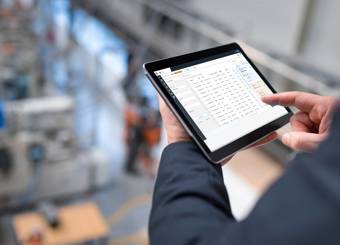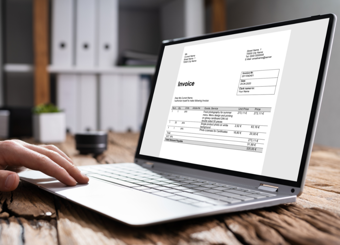What is accounts payable digital transformation?
Organizations around the globe are facing the prospect of digital accounts payable transformation, an inevitable metamorphosis in the modern marketplace. According to recent data from Market Research Engine, the Global Digital Transformation Market is anticipated to reach $1279 billion USD by 2027. Growth will occur at a CAGR of over 18.5% in the forecast period. Clearly, the time of digital accounts payable process transformation is now. Businesses are compelled to implement the technology systems that dominate the B2B market. But what does digital AP transformation mean for the financial team?
Accounts payable process software is highlighted as a critical player in the market for digital AP transformation. The software for an effective accounts payable process transformation ranges from basic bookkeeping tools to advanced automation solutions. The recent Accounts Payable Software Market Report from 360 Market Updates focuses on the types and applications available today with a comprehensive analysis of revenue forecasts, geographic breakdown, and current market availability. Industry experts also speak out at webinars and other events to highlight the benefits and challenges associated with digital accounts payable transformation.
Automation is Here to Stay
A common thread echoed in a multitude of market reports is automation. Automation allows the accounts payable department to shift from being a back-office cost-center to a forward-leaning, strategic asset with better access to and use of the resources and information available.
Within accounts payable, that often features automating the reception and collection of receipts, transactional data, and other information automatically which is then stored in the general ledger. From there, solutions can also offer reporting capabilities, vendor management, invoice workflow automation, and electronic payment automation.
The 360 Market Updates Global Accounts Payable Software Market Analysis and Forecast provide detailed industry analysis. The report includes key vendors within the accounts payable software market, as well as a variety of solution types, such as cloud-based, SaaS, web-based, and on-premise. The report also breaks down the solutions for their market applications, like SMEs, large enterprises, and those that fall outside the traditional scope.
Setting the Scene: Digital Mega Trends that Impact AP
Richard Sears, Partner & SVP at Frost & Sullivan, focuses on the concept that digital transformation is more critical than turning things into data. Keep in mind that this analysis refers to the periods before the COVID-19 pandemic. While the world has slowly begun returning to more normal operations in recent months, organizations should still factor in business continuity and supporting remote workers to remain productive during a crisis - avoiding costly interruptions of operations. Digital transformation is reshaping the landscape and corporate culture of businesses in general and AP departments in particular.
Organizations need to be aware of many trends, as they are all essential drivers for embarking on the digital AP transformation journey:
- Now more than ever businesses must optimize internal and external cost structures to stay competitive in a global and digital landscape.
- The online B2B payments market is here to stay, already worth a massive $250 billion and predicted to continue at a rapid growth pace.
- The digital transformation is happening everywhere, in people’s work-life as well as personal life. People are used to and expect to be able to perform all their tasks on any device, at any time, from anywhere.
Accounts payable departments should leverage the digital AP transformation to focus on the enduser. The digital tools available allow AP to leverage invoice data and customize how data is presented in a much more personal way, providing higher value to the users and the entire organization. This way, an accounts payable software solution can help organizations turn meaningless data into meaningful insights where big data becomes small data because it becomes relevant to the user.
The Account Payable Process Transformation: From Cost Center to Contributor
Judy Bicking, an AP manager veteran with experience from organizations including Johnson & Johnson and the IOFM, has shared her view on AP’s role in this increasingly digital and automated world on a previous blog post. According to Bicking, the digital transformation is not just about using digital tools to perform traditional accounts payable tasks. More importantly, it’s an opportunity to transform the AP function from the traditional back-office processor into a contributor to overall organizational success.
Breaking Down the Silos: AP and Procurement
The first step to enable a more strategic role for AP is to take down the silos separating the AP and procurement teams. Traditionally, the accounts payable and procurement functions are opponents reporting to different C-suite members and striving towards different objectives. Often management does not realize that a chaotic purchasing process creates a chaotic and inefficient accounts payable process. Organizations have much to gain by enabling understanding, cooperation, and shared goals between these teams since in the end they are charged to manage different parts of the same process.
In many organizations, AP professionals are often seen as “just processors” and as administrators keying in data from the invoice into a system. It’s important to stress that even though the AP team members may not have the authority to approve transactions, they do need extensive knowledge of internal controls, regulations, laws, operational requirements, and policies to ensure invoices are handled and paid correctly. Plus, they are often responsible for the supplier relationship as they are the first face to the supplier in most cases.
The “non-PO” or indirect spend requires significant manual work and investigations for the AP team since purchase orders or pre-negotiated contract terms do not regulate these purchases. Per definition, these purchases often happen last minute, from various suppliers potentially causing additional freight and order charges. From AP’s perspective, each of these invoices represents a liability and will hit the company’s cash flow as they arrive in AP, often as a surprise to the finance team. Plus, without a purchase order or contract in place, these invoices cause work for the AP team to try to figure out where the cost belongs and get the appropriate approval from internal buyers.
AP managers need to team up with their counterparts within procurement to align on purchasing processes that will help both departments to be more efficient and provide a better service to the rest of the organization. Today, in many cases the invoice is the trigger of the process, and the first time AP knows that there is a debt. This, according to Judy Bicking, means that “the process is backwards and the main reason for a lengthy and broken accounts payable process leading to frustration for the AP team as well as the rest of the organization.”
AP’s New Role
As part of the accounts payable process transformation at Johnson & Johnson, Judy Bicking realized that her role as the AP manager was no longer to process invoices timely and accurately but rather “to provide accurate and timely data to the financial statements.” This is a significant shift of focus and key to establishing AP as a contributor to the overall organizational success.
This focus on financial data will help grab the CFO’s attention, which is needed to get the C-suite’s approval to invest in automation tools that will help drive efficiency in AP. And AP managers should make sure they gather data to present measurable benefits of AP automation to put a solid ROI calculation in place. Savings include not only the apparent elimination of costs associated with handling paper and old systems but also the soft savings for the organization such as time savings for approvers and improved visibility in financial data. Accounts payable process transformation must start within the AP team. Changing the perception of AP in the organization begins with making the AP team understand their value and feel pride about their contribution to the organizational success. “Processing is what we do, not what we are about.”
Here, AP managers should think of AP as a stand-alone business with themselves as the CEO. By doing so they can identify their product, the customers they serve, and the value they provide to internal as well as external stakeholders. As the “CEO of AP,” it becomes clear they also need to focus on a cost-efficient way to provide their product to stay in business. This is where AP process efficiency KPIs are crucial to measure and monitor performance, identify bottlenecks and implement improvement tactics. These KPIs should be communicated to the team to build pride as well as to the rest of the organization to prove the value of AP.
Automation Is the Only Way Forward
AP managers are under pressure to reduce costs to support organizational growth, which often means handling larger invoice volumes with the same or less staff. It’s more complex than reducing headcount as the goal is to stop burning money with an inefficient process. Put in the words the CFO will understand and appreciate “we need to start managing the cash, not the debt.”
The solution to all of the above is to implement processes for controlled, pre-approved spend and automation tools that will eliminate duplicate payments, the cost of handling paper, and late payment fees from suppliers. Automation will help AP take ownership and control of the entire process, help stay on top of invoices, facilitating approvals when needed, and stop the blame game for good. Plus, with all invoice data in one solution, AP can provide full control and visibility of the organization’s financial situation.
Digital transformation trends in accounts payable and finance are growing, leading the way for businesses to change from manual and paper-based tasks and ultimately drive efficiency within all parts of their financial process. The benefits provided by these solutions are directly important for all players in the finance sector, from the CFO and Controller to the AP Manager or IT Director. Digital transformation for finance is a recognized and valued benefit globally and will become a staple tool across all industries.
AP Automation - From Luxury to Necessity
“Automation is no longer a luxury, it’s a necessity.” - Judy Bicking
There is a common misconception that implementing an AP automation solution is an arduous process that can take months or years before realizing the benefits. With research and assistance, AP departments are discovering cloud-based AP automation solutions that are implemented in just weeks. The rise in availability and the speed with which these powerful solutions can be integrated and launched are the reason why AP automation is no longer a distant possibility, but rather a must-have for all organizations.
Once AP automation solutions are implemented, the AP department will be instantly aware of the immediate benefits. AP automation provides optimum visibility, excellent research management, and the strategic insight to propel a business forward. And AP automation solutions save time and human resources, improve organization within the department, and give personnel access to a full range of information at a glance.
The digital accounts payable process transformation should not be seen as a threat. Instead, it’s an opportunity for the AP team to shift perceptions of them as simple processors to highly efficient and vital contributors to the organization’s growth.






